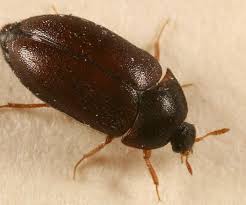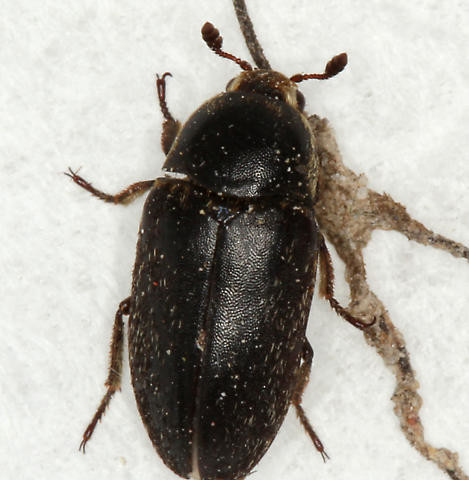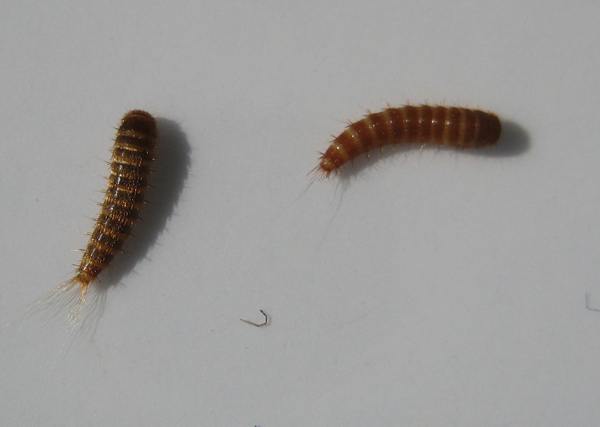Black Carpet Beetle
Attagenus unicolor
(F)
The black carpet beetle is a common carpet beetle in Saskatchewan. The larvae eat almost any type of animal product such as leather, wool, silk, feathers, hair, dried meat, dead insects, and even dried plant material. The black carpet beetle is a pest in kitchen cupboards, as well as in woolen carpets or clothes storage areas.
Description
The adult is 2.8 to 5 mm long, black to reddish brown and covered with short, sparse pubescence (Fig. 1). The first segment of the tarsi of the hind legs is much shorter than the second segment. The last antennal segment of the male is twice as long as that of the female.
The larvae of the black carpet beetle, which may reach 12.7 mm in length, are very different from other carpet beetles’ larvae. They are elongate, carrot-shaped, golden to chocolate brown, and have a tuft of very long, curled, golden-brown hair at the tail end of their body.
Life History
The small, pearly-white egg can be deposited in the lint around baseboards, in the ductwork of hot-air furnace systems, on wool clothing in storage, and in similar protected locations. The egg hatches in 6 to 11 days in warm weather, but may require an additional 5 to 16 days under cooler conditions.
The newly hatched larvae scavenge for food (they will eat dander, hair, and other small bits of food high in protein), avoid light, and move so slowly that they appear to be gliding. At room temperature, the larval life span ranges from 258 to 639 days. This variation is due largely to fluctuations in temperature, food quality, and relative humidity. The larvae may molt 5 to 11 times, and up to 20 times when conditions are unfavorable. The larval skins often are mistaken for the larvae themselves. The larvae pupate in the last larval skin, and the pupal period may extend from 6 to 24 days. The beetles may remain in the partially shed pupal skin from 2 to 20 days before emerging. Black carpet beetles usually overwinter in the larval stage.
Adults may live from 2 weeks to several months, but never damage household goods in this stage. Unlike the larvae, they are attracted to light. They are active and often can be found around windows and outdoors on flowers, eating the pollen. The females commence egg laying on the larval food materials or in dark secluded places less than one week after emergence. A female can lay from 42 to 114 eggs, and averages around 50; she generally dies a few days after oviposition.
How do Black Carpet Beetles Get Into the House?
The adults are attracted to flowers, and in the spring of the year they may fly into the house. The larvae may wander from the nest into the attic and other parts of the house. At times, birds and other animals die in chimneys and elsewhere in the house and their carcasses become a source of food for the larvae. Very often, the black carpet beetles are brought into the house with old woolens and carpeting. Sometimes the black carpet beetles are introduced into a dwelling in stored products such as dried dog food.
It is not uncommon to find one or two black carpet beetles in a house. An occasional black carpet beetle larva probably is not an indication of a serious problem; however, if you regularly encounter large numbers of larvae or adults, find the source of the infestation and institute the following control measures.
Management
Successful control depends on locating the source of the infestation. It may be a woolen toy stored in the basement, soiled woolen socks in boots, a felt hat on a shelf, carcasses of birds or other animals, dead insects in walls or attic, bits of dried dog food, or similar materials. If you find the infested material, either clean it or destroy the item.
Crevices where lint, hair, and food particles have accumulated are places likely to be infested by carpet beetles.



